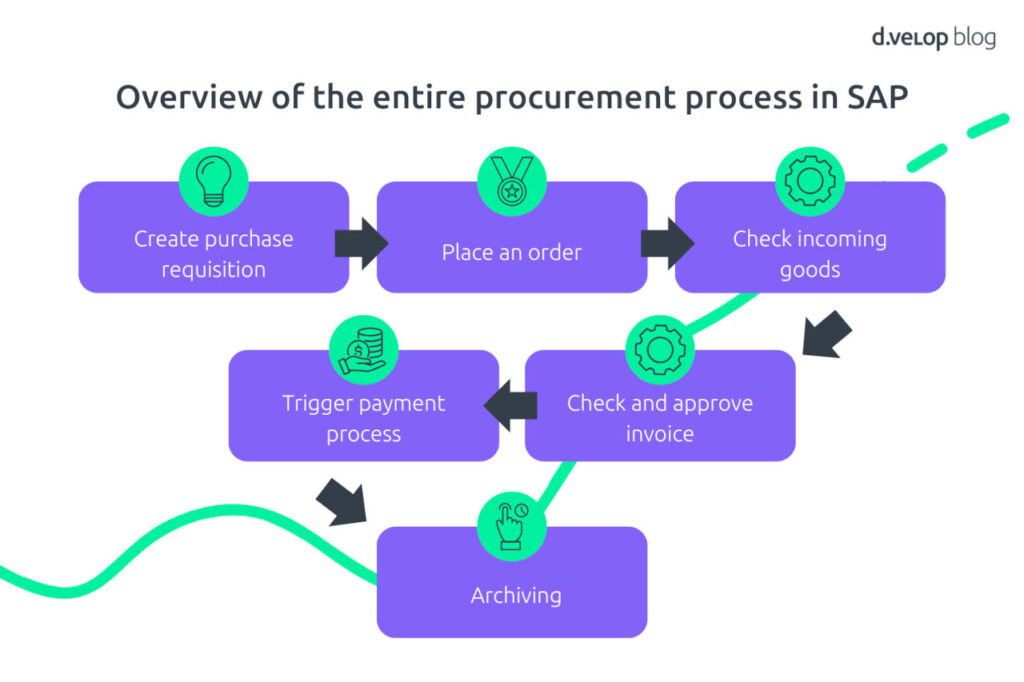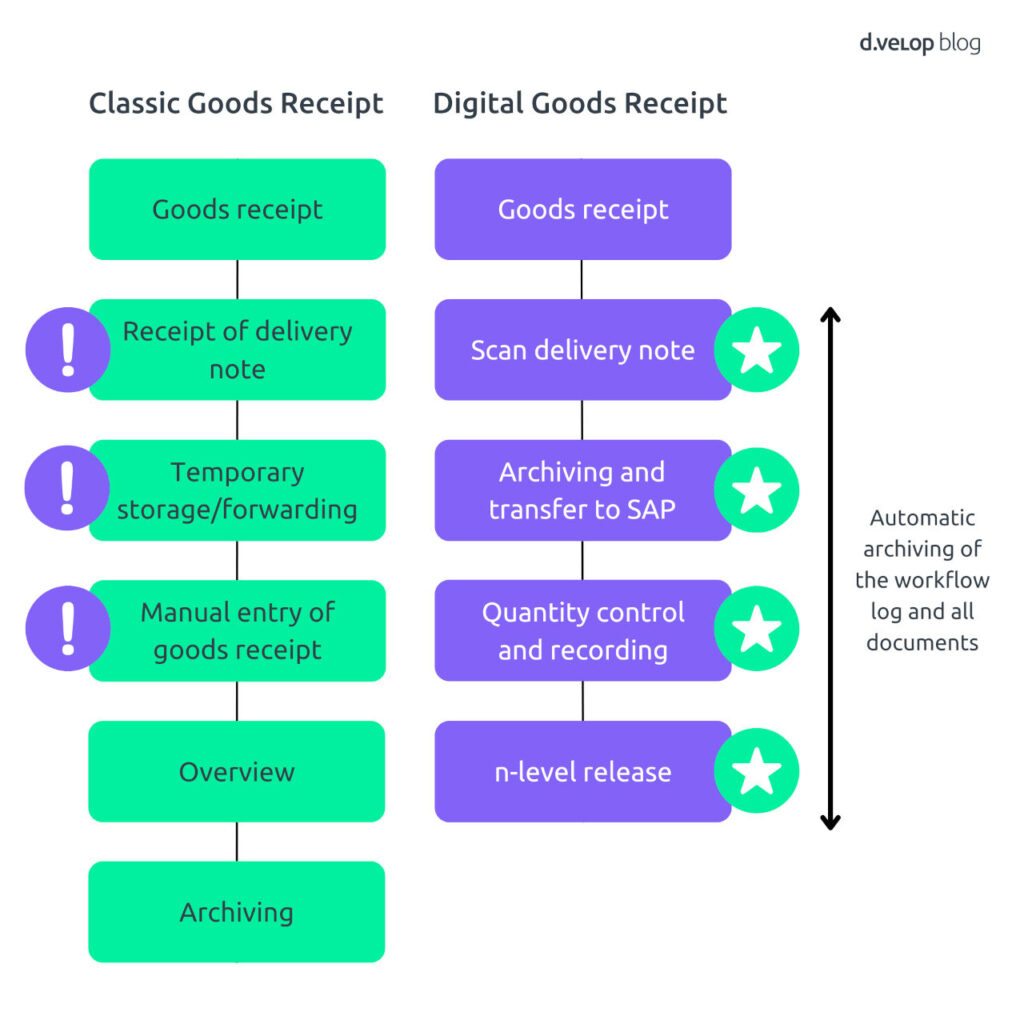Goods receipt is a key process in every organisation. It ensures that incoming goods arrive in the correct quantity, of the expected quality, at the right time and at the designated location. However, a paper-based goods receipt process is often time-consuming and prone to errors. Delivery notes must be entered and matched manually, which can lead to delays and inaccuracies. This article focuses on the digital procurement process in SAP, with a closer look at SAP goods receipt within the system.
In previous articles, we have already explored the entire Purchase-to-Pay process as well as SAP purchase requisitions. This step is crucial, as timely delivery of the requested goods is the goal following a successful purchase order. Within the SAP procurement process, we now turn our attention to the goods receipt stage.

SAP Goods Receipt Check – The Right Goods, in the Right Place, at the Right Time
he goods receipt process is all about quickly verifying whether the received goods have arrived in the correct quantity, of the expected quality, at the right time, and at the correct location within the organisation. During this process step, the following key questions must be checked and documented:
- Has the delivery/goods shipment arrived?
- Is the delivery complete and free from defects?
- Can the incoming goods be posted?
- Can invoice verification in logistics be performed?
- How can I assign the delivery note to the order and then to the invoice?
At first glance, this seems to be a demanding, but not impossible task. To get a feel for the complexity of verifying and inspecting incoming goods, let’s consider an example:
Case Study: Goods Receipt in a Multi-Location Environment
A company orders goods through its headquarters in Frankfurt. The goods are subsequently delivered to Frankfurt and subsidiaries in Munich and Hamburg. At each location, the incoming goods are checked and then accounted for on the delivery note. Only after each delivery note has been received by headquarters the incoming goods can be documented, albeit late.
Even relatively minor factors, such as different company locations, can significantly impact the goods receipt process in SAP. It’s easy to imagine how error-prone and inefficient a non-automated goods receipt could be.
Paper-Based Goods Receipt: Risks Around Every Corner
A traditional, paper-based goods receipt process in SAP involves numerous manual steps. Initially, the received goods must be checked for completeness and quality. If everything is in order, the signed delivery note is placed in a temporary tray and forwarded to the purchasing department or sent via internal mail to the company’s head office. This marks the first delay in the process.
Once the documents reach the correct department, the goods receipt is manually recorded. The responsible employee must locate the correct purchase order in SAP and post the goods receipt. Due to the high level of manual data entry, this stage of the process presents a significant risk of errors, which can have far-reaching consequences for other departments, such as Finance and Accounting.
Next, the delivery note must be manually matched to the original purchase order. Documents need to be stored physically within easy reach of staff for quick access, which inevitably leads to space and coordination issues.
Even after the goods receipt has been posted, the administrative effort remains high. Typically, spreadsheets must be maintained to track the current status of goods receipts. Overall, a non-automated goods receipt process is extremely time-consuming and error-prone. Throughout the entire workflow, there is a constant risk of losing delivery notes, documents or handwritten memos.
All the more reason to consider switching to an automated goods receipt process.
Digital incoming goods process: Record and post deliveries in real time
In contrast to the traditional process, delivery notes are scanned and recorded in the automated process right after the incoming goods have been received. OCR recognition is used to read delivery notes and relevant data, including supplier, order number, and order quantity, which is directly transferred to the SAP system. You can use workflows to electronically forward data from the delivery notes to the appropriate colleagues for processing. During this process, the delivery note is archived in an audit-proof manner.
One of the key benefits of a digital goods receipt process lies in its direct integration with the corresponding purchase order. During scanning, the system automatically compares and links the goods receipt with the relevant order. This allows warehouse or procurement staff to instantly see whether the delivery is complete by matching the order items with the received goods.
Once verified, the goods receipt can be recorded. For raw materials that are critical to production, a multi-level approval workflow can be configured to ensure that only authorised personnel with full process oversight are permitted to post the goods receipt.

The Benefits of Digital Goods Receipt Control at a Glance
- Immediate overview of incoming goods
- Rapid verification and direct posting of deliveries in SAP
- Acceleration of downstream processes, especially of incoming invoice processing in logistics
- Automatic delivery note archiving
Since the benefits are clear now, the only thing that lacks is the right solution. With the overview of your incoming goods provided by d.velop delivery note for SAP ERP, you know right away when a delivery has arrived in the decentralized warehouse. The delivery can be checked and the corresponding material document for the delivery can be entered directly into SAP and then posted. You can find all the information on our page about the digital procurement process in SAP.
A Few Steps to Automated Procure-to-Pay Processes in SAP
Gain insight into what a digital procurement process looks like and its benefits over the traditional process.
